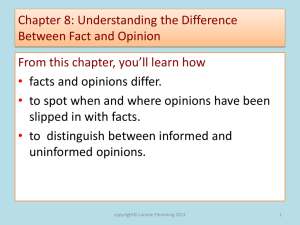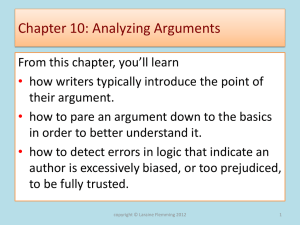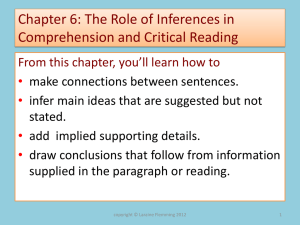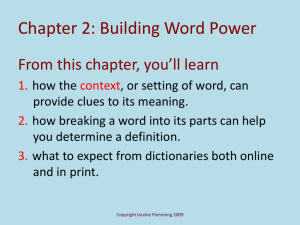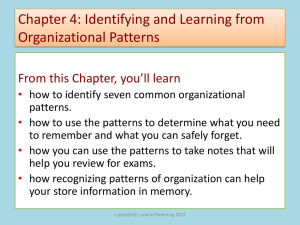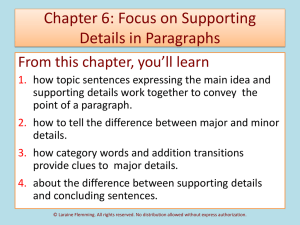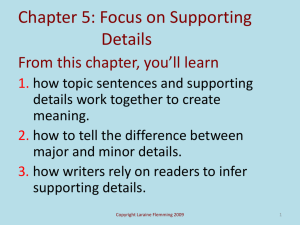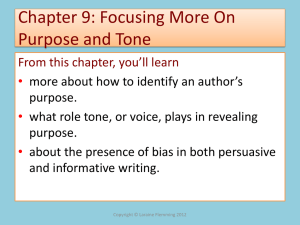Chapter : Understanding Patterns of Organization
advertisement
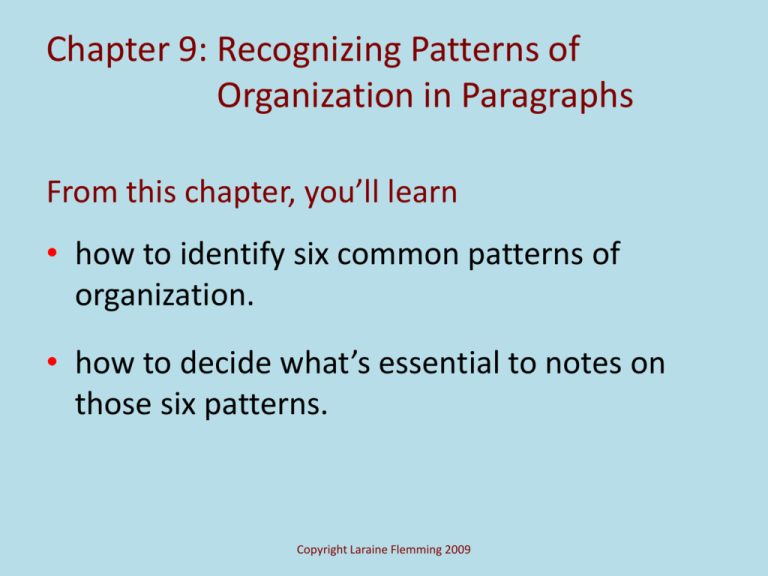
Chapter 9: Recognizing Patterns of Organization in Paragraphs From this chapter, you’ll learn • how to identify six common patterns of organization. • how to decide what’s essential to notes on those six patterns. Copyright Laraine Flemming 2009 9.1 Defining Terms Patterns of Organization • develop naturally or are selected based on the main idea. • are emphasized by writers to make the relationships between ideas clear to readers, e.g., writers use specific transitions that help readers connect sentences. • give readers a way of organizing information in long-term memory, e.g., readers can mentally categorize information into causes and effects, steps in a process, similarities and differences, etc. • are characteristic, or typical, methods of developing ideas in writing. Copyright Laraine Flemming 2009 A Word to the Wise Keep in mind that organizational patterns are dictated by the writer’s main idea, not the other way around. Writers may stick to one pattern of development, combine two or three, or dispense altogether with any pre-existing patterns of organization. The method of development always depends on what the idea being put forth calls for. Sometimes, when students learn about organizational patterns, they think that maintaining the pattern is more important than developing their point. It isn’t. Writers don’t write cause-and-effect essays. They write essays, articles, or, indeed, entire books, that may (or may not) use the causeand-effect pattern of organization to convey ideas. Copyright Laraine Flemming 2009 The Six Patterns of Organization 1. Definition: offers a detailed meaning of a word or phrase. 2. Time Order: Sequence of dates and events: traces the events in a career or the events preceding a cultural or social change. Process describes the steps in a sequence to explain how something functions or occurs in real time. Both require the author to organize the supporting details according to when events or steps occur (or occurred) in real time. 3. Simple listing: presents, in any order, characteristics, attitudes, studies, etc., supporting or explaining a point. 4. Cause and effect: explains how one event led to or produced another. 5. Comparison and contrast: shows how two topics are similar or different in order to develop the main idea. 6. Classification: describes the sub-groups that make up some larger whole. Copyright Laraine Flemming 2009 A Word to the Wise Patterns of organization in paragraphs don’t always come in the purest form. Sometimes they are mixed together in exactly equal measure. Much of the time, though, one pattern is primary, or the most important. That’s the one you want to identify. The primary pattern is used for the majority of sentences in the passage and is central to explaining the main idea. Copyright Laraine Flemming 2009 Which pattern do you think is primary in the following paragraph? Is it cause and effect or sequence of dates and events? • When Elvis Presley, the acknowledged king of rock and roll died in 1977, he was horribly overweight, addicted to countless drugs, and subject to fits of rage. Exactly what caused Presley’s decline is unknown, but many have speculated that insecurities about his talent may have tormented him more than most realized. Like actress Marilyn Monroe, Presley would have liked to be taken seriously as an actor, but critics treated his attempts at dramatic roles as a joke. In addition, the entertainer seems never to have quite recovered from the loss of his mother in 1958 or his stint in the army, and the two events seem to have broken his spirit. When he returned to civilian life in 1960 and resumed his career, Presley was a changed man, and his music had lost its old energy and spark. Copyright Laraine Flemming 2009 1. Pattern Characteristics Definition: The topic sentence introduces a key word or phrase, followed by one or more meanings. • Often the key word or phrase is in italics or • boldface. The paragraph fleshes out the definition by giving an example of the word in context or providing some general background. Copyright Laraine Flemming 2009 1. Definition Pattern: Example Deinstitutionalization is a mental health policy that emerged in the 1960s. The policy redirected care of persons with severe mental disorders from state mental hospitals to community-based treatment settings. Based on the policy of deinstitutionalization, many state hospitals were closed and replaced by community mental health centers or residential treatment facilities. Copyright Laraine Flemming 2009 Pattern Pointers for Notes Make sure you 1. can paraphrase the definition, summing it up in your own words. 2. remember how the definition is related to any specific people, events, or dates. 3. understand how the details supplied relate to the definition. Copyright Laraine Flemming 2009 2. Pattern Characteristics Time Order: Dates and Events: The paragraph (1) includes a number of dates and events comprising someone’s life or career or (2) traces the events that preceded a particularly important social change or historical occurrence. • The pattern is likely to include transitions such as by 1972, after the fall of 1941, in the summer of 2010. • The events are ordered according to how they occurred in real time. Copyright Laraine Flemming 2009 2. Dates and Events Pattern: Example • Congresswoman Barbara Jordan’s life was punctuated by a long list of personal and professional achievements. Born in Houston, Texas in 1936, Jordan made history in 1966 when she became the first African American to serve in the Texas senate since 1883. On March 21, 1967, she became the first African American to preside over the state senate. In 1972, Jordan ran for Congress and won. She gained national prominence during the televised Watergate proceedings of 1974, when her eloquence impressed a national audience. In 1976, she became the first African American to give a keynote address before the Democratic National Convention. Jordan retired from politics in 1979 due to ill health. She died in 1996. Copyright Laraine Flemming 2009 Pattern Pointers for Notes • A series of dates and events is a strong clue to the presence of this pattern. So too are topic sentences like “Creative writing programs are not a modern invention, college catalogues indicate their existence starting in 1897 and continuing to the present.” Copyright Laraine Flemming 2009 A Word to the Wise Keep in mind, though, that one or two dates and events don’t usually indicate that the primary pattern is a sequence of dates and events. Passages that mention several dates and events or make references to a number of dates and events are likely to be relying on this method of organization. One or two dates and events, however, do not add up to an overall pattern of development. Copyright Laraine Flemming 2009 2. Pattern Characteristics Time Order Process: The paragraph explains how something functions, happens, or develops • A specific number of individual steps or strategies are named and described. • Transitions like first, second, next, and at the end often introduce the steps or stages. • The order in which the steps or stages are presented is based on events in real time. Copyright Laraine Flemming 2009 2. Process Pattern: Example • The earliest box camera had four essential parts—shutter, lens, box, and film—and three essential steps. When a picture was taken, the shutter opened, allowing light to enter. Then the lens, a circular piece of glass, focused the light so it passed through the box. In the third and final step, the light-sensitive film at the back of the box received and recorded the image. Copyright Laraine Flemming 2009 Pattern Pointers for Notes Make sure you 1. can identify and describe the individual steps or stages. 2. know any specialized vocabulary necessary to understanding the steps in the process. 3. consider using a flow chart that diagrams the individual steps, phases, or stages. Copyright Laraine Flemming 2009 Sample Flow Chart: Box Camera’s Three Steps Shutter opens and allows light to enter. The lens focuses the light and lets it pass through. Copyright Laraine Flemming 2009 Lightsensitive film at back records image. 3. Pattern Characteristics Simple Listing: The paragraph identifies or names a number of specific features, characteristics or examples that require no specific order of presentation. • The pattern is likely to include topic sentences with phrases such as “several key cases,” “a number of symptoms,” or “several studies.” • The details give specifics about the cases, symptoms, or studies, but they require no specific order of presentation; they can be rearranged to suit the author. Copyright Laraine Flemming 2009 3. Simple Listing Pattern: Example • There are three ways to ruin even the best friendship. Best friends tell each other secrets they would be unlikely to tell anyone else. Betray that confidence, and the friendship can end overnight. If a best friend’s romance goes down in flames, don’t date the ex. No matter what your friend says, he or she will not be happy about the two of you getting together. Finally, if your best friend confides in you about a problem, don’t immediately come up with a solution. Sometimes friends just want a listener, not a problem solver. Copyright Laraine Flemming 2009 Pattern Pointers for Notes • If the topic sentence announces the number of items to be listed—“There are three things you need to do to complete a successful job interview”—you know right away that you need to record at least three supporting details. • Consider using diagrams for passages using the simple listing pattern. Details that have no intrinsic, or natural, order are sometimes hard to remember. Diagramming them can be a memory booster. Copyright Laraine Flemming 2009 Diagrams can help you remember by giving you a visual image to attach to the author’s words. Betraying a friend’s secrets How to lose a best friend Dating the ex Always being a problem solver. Copyright Laraine Flemming 2009 4. Pattern Characteristics Comparison and Contrast: The similarities and/or differences between two topics are discussed in detail. • The comparison and contrast pattern has to have two topics. • Transitions such as in contrast, similarly, and however turn up frequently. • The supporting details describe similarities and/or differences. Copyright Laraine Flemming 2009 4. Comparison and Contrast Pattern: Example • Men have a harder time adjusting to widowhood than women do. Although both sexes suffer profoundly at the loss of a spouse, men seem to have more problems. They have difficulty, for instance, managing the household chores once performed by their wives. They also have difficulty keeping in touch with old friends because it was the wife who, in the past, kept up the couple’s social network. Copyright Laraine Flemming 2009 Pattern Pointers for Notes • Don’t get so caught up in the similarities and differences, you forget what they are there for. Be sure you understand and record the main idea they develop. • Make your notes a visual reflection of the pattern by putting the similarities and differences into columns. Copyright Laraine Flemming 2009 Widowhood is harder on men than women. • Men have trouble running the household. • Women are used to maintaining a household. • Men aren’t used to keeping in touch with a circle of former friends. • Women don’t have difficulty keeping up social ties. Copyright Laraine Flemming 2009 5. Pattern Characteristics Cause and Effect: The paragraph explains how one event produced or set off another event or train of events. • The paragraph is likely to include verbs like caused, triggered, created and induced. • It’s also like to include transitions such as consequently, as a result, due to and in response. Copyright Laraine Flemming 2009 5. Cause-and-Effect Pattern: Example • In 2001 Abdel Baset al-Megrahi, who took part in the 1988 bombing of Pan Am Flight 103 over Lockerbie, Scotland, was released from prison. Megrahi’s act had resulted in the death of all 259 people on board, and he had been sentenced to life. However, because he was suffering from incurable prostate cancer the Scottish Judge Kenny MacAskill decided Megrahi was deserving of compassionate release. According to MacAskill, Megrahi’s condition obliged the court to show mercy, especially since the man would soon be judged by a “higher power.” Copyright Laraine Flemming 2009 Pattern Pointers for Notes • Be aware that this pattern can identify a series of causes or effects. Don’t assume that identifying just one cause and one effect completes your notes—or your understanding of the passage. • Be aware as well that sometimes causes can produce effects that turn into causes. Think of it this way: Too much pollen in the air can cause you to cough a lot. Coughing, in turn, can cause yet another effect, in this case, laryngitis or loss of your voice. Copyright Laraine Flemming 2009 6. Pattern Characteristics Classification: The topic sentence describes how some larger group can be broken down into smaller subgroups. • topic sentences include words like categories and subgroups. • topic sentence use verbs like broken down into, analyzed, or divided. Copyright Laraine Flemming 2009 6. Classification Pattern: Example • The animal kingdom is divided up into groups called phyla (phylum is the singular.) Single-celled animals like amoeba, for instance, belong to the phylum called Protozoa while sponges belong to the category labeled Porifera, and round worms are classified as Nemanthelminthes. Clams and snails belong to the category called Mollusca, and insects are grouped under the heading Arthropoda. And what category are humans in? Humans, along with fish, birds and reptiles, belong to the category Chordata. Copyright Laraine Flemming 2009 Pattern Pointers for Notes • Make sure you know what larger group is being sub-divided and how many categories emerge as a result of the division. • If the categories described are given specific names, be sure to put the names into your notes. • When you finish a passage that relies mainly on the classification pattern, test your understanding by seeing how well you can name and describe the individual categories. Copyright Laraine Flemming 2009 Finishing Up: Recognizing Patterns of Organization in Paragraphs You’ve previewed the major concepts and skills introduced in Chapter 9. Take this quick quiz to test your mastery of those skills and concepts, and you are ready to read the chapter. Copyright Laraine Flemming 2009 Finishing Up: Recognizing Patterns of Organization in Paragraphs Identify the pattern of organization suggested by each sentence and explain what it was about the sentence that guided your choice: 1. Changing a person’s attitude is not easy, but it can be done and there are several techniques that can successfully be used to bring about change. 2. As first ladies go, no two were more distinctly different from one another than Jacqueline Kennedy and Patricia Nixon. Copyright Laraine Flemming 2009 Finishing Up: Recognizing Patterns of Organization in Paragraphs Sentence 1 is cause and effect because it • emphasizes how one thing produces, or brings about, another. Sentence 2 is comparison and contrast because it • introduces two different topics, Jacqueline Kennedy and Patricia Nixon. • points out how they differ. Copyright Laraine Flemming 2009 Finishing Up: Recognizing Patterns of Organization in Paragraphs Identify the pattern of organization suggested by each sentence: 3. In the corporate world, the term “means-end analysis” refers to analyzing a task in order to discover the method of action that would get you most quickly to your final goal. 4. Depending on the method of division, glaciers can be grouped into three or four different categories. Copyright Laraine Flemming 2009 Finishing Up: Recognizing Patterns of Organization in Paragraphs Sentence 3 suggests the definition pattern because • the opening phrase “means-end analysis” is followed by a restatement of the phrase’s meaning. • quotation marks (could also be italics or boldface) highlight the opening phrase. • the verb “refers” suggests a definition pattern will follow. Sentence 4 suggests the classification pattern because • it explains how some larger whole can be sub-divided into smaller groups. • combines the words “division,” “categories,” and “grouped” in the same sentence. Copyright Laraine Flemming 2009 Finishing Up: Recognizing Patterns of Organization in Paragraphs Identify the pattern of organization suggested by each sentence: 5. Russia’s Prime Minister, Vladimir Putin, has had a long and generally sinister career. 6. In order to remember new information for more than a few minutes, the human brain requires that several steps be completed in the following order. Copyright Laraine Flemming 2009 Finishing Up: Recognizing Patterns of Organization in Paragraphs Sentence 5 suggests a sequence of dates and events pattern because • • the topic sentence focuses on Putin’s career. it is impossible to discuss a “long career,” even a sinister one, without discussing the dates and events that make up the career. Sentence 6 suggests a process pattern because • • the topic sentence explains how something happens. the topic sentence uses the phrase “a certain number of different steps.” Copyright Laraine Flemming 2009 Finishing Up: Recognizing Patterns of Organization in Paragraphs Identify the pattern of organization suggested by this sentence: 7. There are a number of specific things you should not do when preparing to buy a new or used car. Copyright Laraine Flemming 2009 Finishing Up: Recognizing Patterns of Organization in Paragraphs Sentence 7 is simple listing because • the phrase “a number of specific things” appears in the topic sentence. • the order in which those “things” are explained does not seem important. Copyright Laraine Flemming 2009 Brain Teaser Challenge Copyright Laraine Flemming 2009 Brain Teaser Challenge Read the following quotation from Bruce Lee, the actor who became famous displaying his very real martial arts abilities in a string of successful films. In your own words, what does he mean to say about pattern, and do his words apply to the patterns of organization you just learned to recognize? “All fixed set patterns are incapable of adaptability or pliability.* The truth is outside of all fixed patterns. “ Pliability: flexibility, capable of changing or bending Copyright Laraine Flemming 2009
